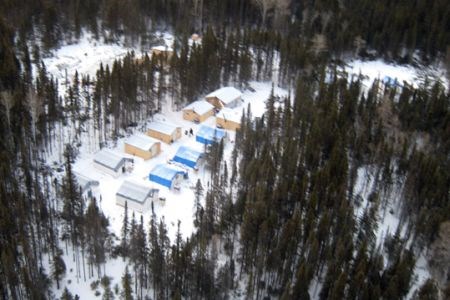The first stage of a federal environmental assessment on Cliffs Natural Resources' chromite project in the James Bay region began in October.
The Canadian Environmental Assessment Agency (CEAA) began taking written submissions last month on the massive, multi-billion dollar regional mining, transportation and processing development slated for the McFauld's Lake exploration camp.
The agency announced Oct. 7 that a comprehensive study of the Cliffs project in the 'Ring of Fire' has formally started with a notice of commencement.
While it's clear that Black Thor will be the first chromite deposit to be mined starting in 2015, and the Nakina-Aroland area will be the site for a transload facility, the final location of a much-coveted ferrochrome production facility remains up in the air.
But CEAA spokeswoman Celine Legault said the federal regulator will be working from the project description submitted by Cliffs, which identifies Sudbury in its “base case,” as the site for the electric arc furnaces.
“This is the information we will be using for the environmental assessment,” said Legault. “If this part of the project description changes during the (assessment), the agency will consider these changes carefully and make a decision at that time,” said Legault.
Sudbury was identified earlier this year by the Ohio-based international miner (and again in September) as the leading front-runner to host the ferrochrome plant, ahead of Nakina, Timmins and Thunder Bay.
The property under consideration is a vacated brownfield site 20 kilometres north of the community of Capreol. It's within a kilometre of the Canadian National Railway's main line which runs northwest to Nakina.
Bill Boor, Cliffs' senior vice-president for global ferroalloys, said the 30-day comment period “is, by far, not the only opportunity” for the public to have their say on the environmental aspect of the project as it advances.
“We'll have this furnace issue resolved with plenty of opportunity for people to participate in the process.”
He gave no timeline when a decision is forthcoming.
“If you took me back in time, I would have liked to already had it made. I'm not going to put a date on it, but it's a high priority for us to figure that out,” said Boor. “Every other aspect of the project is pretty clear.”
The production process would employ electric arc furnaces which would produce between 1,250 and 1,750 tonnes of ferrochrome daily to be sold for stainless steel manufacturing in North America and internationally.
The facility would employ between 350 and 450 people when operational. The furnaces would require 300 to 350 megawatts of power.
Boor said the price of power in Ontario, compared to neighbouring provinces, remains an issue. But he expressed confidence that discussions with the Ontario government should accelerate with the provincial election now over.
Boor said Manitoba and Quebec are among “several alternatives” also under consideration for a processing site.
“Security of pricing is important to us, but I don't want to go too far on the discussions going on with the government and different provinces. It's obvious to say we're not doing a short-term project and security of power rate is very important to us.”
Cliffs' Black Thor deposit is now in the pre-feasibility planning stage, which is expected to be completed by the end of this year. Plans call for a two-pit surface and underground operation with 30 years of mine life.
The CEAA's comprehensive study is one of three types of environmental assessments. It tends to be geared to large projects with the potential for major adverse environmental effects.
Legault said the study could widen to a joint review panel if the federal environment minister deems there is sufficient public concern or considerable environmental impacts that can't be mitigated.
A joint review panel involves an appointed group of experts who review and assess a project by inviting open discussion and exchange of views involving a large number of interest groups and members of the public.
This process is being used at Stillwater Mining's Marathon PGM mine project near the north shore of Lake Superior for the first time in Ontario.
Mining Watch Canada, an Ottawa-based industry watchdog group, wants the assessment process to be bumped up to the review panel stage where there is a greater degree of public involvement.
“We think it's a better process,” said spokesman Ramsey Hart, “which has been used in other jurisdictions across Canada.”
The review panel allows for mayors, First Nations elders and the public to voice their concerns in general and technical sessions, while a comprehensive study is merely a “paper exercise” of written comments.
With a comprehensive study, Hart said the CEAA only provides $40,000 for groups or individuals to be heard, while a review panel provides five times more funding. That's vital for a large project with fundamental questions about the exact location of a transportation route or a ferrochrome processing plant.
“You've got a lot of different interests to weigh as well as the potential for significant environmental impacts in an area that has not seen massive industrial development of this kind.”




